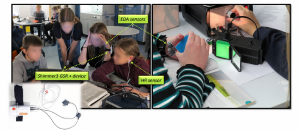In engineering discipline, everything is distilled into the numbers and while doing so the engineers work over their hypothesises without paying attention much to social perspectives, cultural differences and geography particularly we are assigned individual tasks. However, more complex engineering problems and systems necessitate collaborative engineering and collaboration turns into vital components in designs of solutions that affect societies and communities. This trend can be easily verified by checking publication records in any engineering field. For instance, the Fig. 1 given in [1] illustrates the trend in the number of authors in the Journal of Applied Ecology from 1960s to 2010s. As it can be seen that there exists drastic incline for single-author publications and we can see 6 authors publications in average at the end of 2010s. Work in a community will yield better outcomes in terms of efficiency and enabling multiple idea and concepts into single research outcome. From this aspect, no surprise, we can say that existing engineering research tends to more collaborative and it is so important to develop collaboration skills from earlier education.

Fig. 1. Changes in the number of authors on standard research articles published in Journal of Applied Ecology since 1966, showing (a) the exponential growth in the mean number of authors per article and (b) the exponential decline in single-author articles
When it comes to collaborative work, the goal should receiving more than the sum of individual efforts. To do so, the collaboration environment should boost productivity and sustain harmony between individuals. Even in engineering world, these elements lies on different dimension rather than digits, i.e., learners’ beliefs and feelings, previous experiences and personal biases [2]. Since there is no second change for the first impression, I believe it is better to survey each individual’s previous experience before any collaborative work and ask each individual’s feeling after completing collaborative work. By this way, it can give an opportunity to address existing shortcoming and problems before turning them into some personal biases which can affect the rest of the studies. During Topic#3 week, I have found an interesting study [3] in which proposes a novel collaborative learning design where the technology is being utilized to support the awareness of motivation, emotion, and their regulation. Specifically, the data is being collected during the 7-weeks of students’ collaborative work from video recordings and individual-level physiological measures thanks to sensor-type devices as shown in Fig. 2. When I see this picture, I think that it might trigger some discomfort when some sensors are connected your body and your session is being recorded but at least, it can open a way to focus on emotional aspects of individuals during collaborative work which is mostly ignored in goal-focused group works.

Fig.2. The students being observed during collaborative work [3]
To sum up, collaborative work is inevitable when dealing with more complex problems and boosting productivity lies on mutual commitment and emotional regulation of each individual.
References
[1] Barlow, Jos, et al. “On the extinction of the single-authored paper: the causes and consequences of increasingly collaborative applied ecological research.” Journal of applied ecology. 55.1 (2018): 1-4
[2] Pekrun, R. (2016). “Academic emotions,” in Handbook ofMotivation at School, 2nd Edn, eds K. R.Wentzel and D. B. Miele (New York, NY: Routledge), 120–144.
[3] Herrera-Pavo, Miguel Ángel. “Collaborative learning for virtual higher education.” Learning, Culture and Social Interaction 28 (2021): 100437, https://doi.org/10.1016/j.lcsi.2020.100437.
[4] Wenger, E. (1998). Communities of practice: Learning, meaning, and identity. Cambridge University Press. https://www.cambridge.org/dk/academic/subjects/psychology/social-psychology/communities-practice-learning-meaning-and-identity?format=PB&isbn=9780521663632
Ian Chan
Wow, the pictures of the students being observed in Fig. 2 look interesting! Do you know what they were measuring?
Mir Riyanul Islam
Hi,
It was very exciting to read your reflection on collaborative learning. In fact, your justification for the advantages of collaborative learning through the illustrations in Fig 1. is commendable. For the other study on students with different sensors on their bodies, I would say from my own experience of conducting similar studies with those sensors, it is quite discomforting to have those on the body. However, the outcome of these studies is of great value as they capture an individual’s intrinsic characteristics. I believe, through gamification, incentives and considering the greater interest in learning, these discomforts of the students can be compensated. Again, your reflection was a great read, thank you.